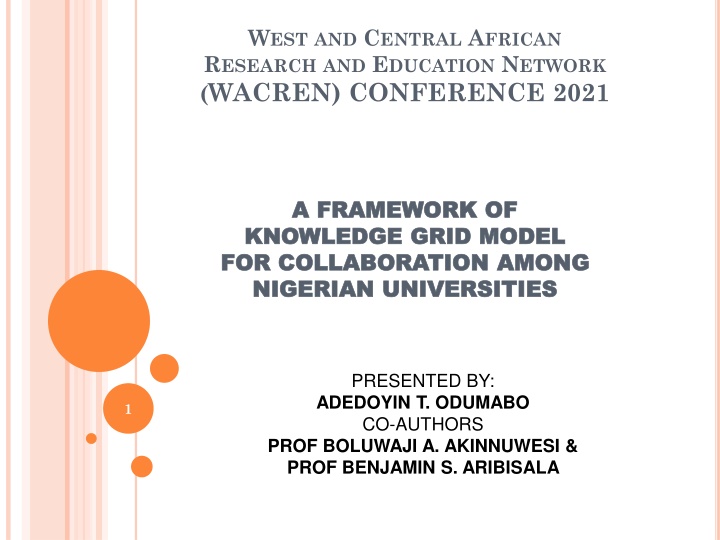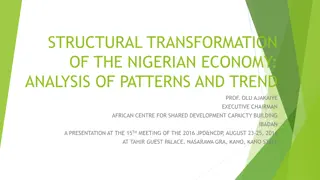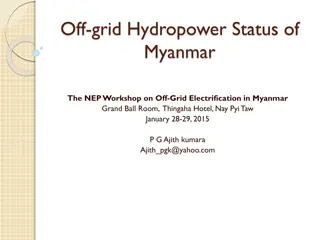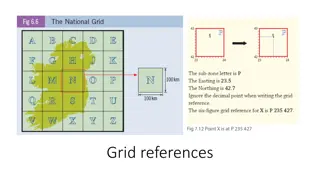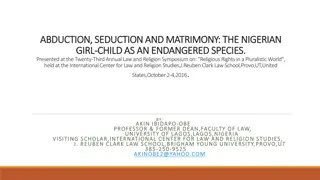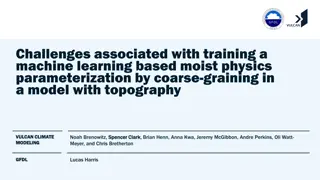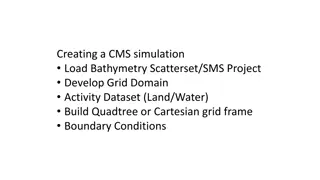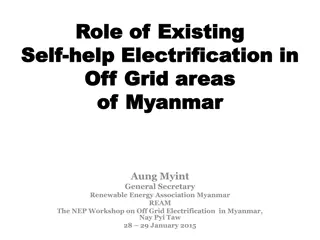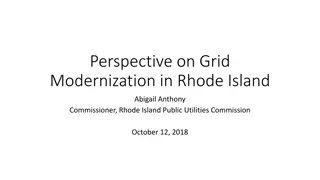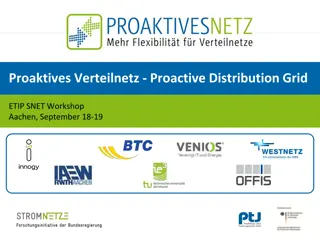Key Insights on Knowledge Grid Models for Collaboration Among Nigerian Universities
This presentation discusses the framework of a knowledge grid model for collaboration among Nigerian universities, emphasizing the importance of information sharing for national knowledge building and management. It explores existing architectures and proposes a new model to enhance cooperation and resource utilization. The classification of Nigerian universities based on specialization is also highlighted.
Download Presentation

Please find below an Image/Link to download the presentation.
The content on the website is provided AS IS for your information and personal use only. It may not be sold, licensed, or shared on other websites without obtaining consent from the author.If you encounter any issues during the download, it is possible that the publisher has removed the file from their server.
You are allowed to download the files provided on this website for personal or commercial use, subject to the condition that they are used lawfully. All files are the property of their respective owners.
The content on the website is provided AS IS for your information and personal use only. It may not be sold, licensed, or shared on other websites without obtaining consent from the author.
E N D
Presentation Transcript
WEST AND CENTRAL AFRICAN RESEARCH AND EDUCATION NETWORK (WACREN) CONFERENCE 2021 A FRAMEWORK OF A FRAMEWORK OF KNOWLEDGE GRID MODEL KNOWLEDGE GRID MODEL FOR COLLABORATION AMONG FOR COLLABORATION AMONG NIGERIAN UNIVERSITIES NIGERIAN UNIVERSITIES PRESENTED BY: ADEDOYIN T. ODUMABO CO-AUTHORS PROF BOLUWAJI A. AKINNUWESI & PROF BENJAMIN S. ARIBISALA 1
OUTLINE OF PRESENTATION OUTLINE OF PRESENTATION Introduction Knowledge Grid Knowledge Grid Architectures Existing Knowledge Grid Models Deduction from Reviewed Literature Research Aim Proposed Knowledge Grid Model The Framework of Knowledge Grid for collaboration Conclusion 2
INTRODUCTION INTRODUCTION A University is a high citadel of learning and the centre for research, innovation and economic development. Nigeria has 170 universities (Federal = 43; State = 48; Private = 79) see table in page 4 Unfortunately, collaboration amongst them is extremely limited and resources sharing is very difficult. Data from each University is largely managed locally with access to external bodies. This lack of information sharing is a major hindrance to the building and management of a quality national knowledge. 3 Knowledge-based economy is better than an economy based on land, labour or capital
NIGERIANUNIVERSITIESCLASSIFICATION The classification of Nigerian Universities based on their specialization. As at 2019, total no of universities is 170. The link is www.nuc.edu.ng or campusbiz.com.ng/listofuniversities. Table:1 SPECIALIZATION FEDERAL UNIVERSITIES STATE UNIVERSITIES PRIVATE UNIVERSITIES AGRICULTURE 3 NIL NIL CONVENTIONAL 30 35 74 EDUCATION NIL 2 NIL MEDICAL NIL 2 2 MILITARY 5 NIL NIL PETROLEUM 1 NIL NIL SCIENCE & TECHNOLOGY TECHNICAL NIL 6 1 NIL 1 NIL TECHNOLOGY 4 2 2 TOTAL 43 48 79 4
KNOWLEDGE GRID Knowledge Grid (KG) is a set of well-organized knowledge together with a set of knowledge management operations. It is a mechanism that shares and manages the distributed heterogeneous resources spread across the internet in a uniform way. KG allows scientist to share data and computer resources. It offers tools for data curation and data processing. Area of application Commercial Academic * Business * General * Biomedical * etc 5 KG has been adopted in developed nations e.g. Europe, Asia, and USA but not in Nigeria
KNOWLEDGE GRID ARCHITECTURES There exist several Knowledge Grid Architectures MODEL NAME YEAR COUNTRY Cannataro et al. Knowledge Grid Architecture 2001 Italy, Europe Universal Knowledge Grid Architecture 2004 China, Asia Wang and Ji s Knowledge Grid Architecture 2005 China, Asia 6
CANNATARO ET AL. KNOWLEDGE GRID ARCHITECTURE(General) Allows the cooperation of scientists across different research centres to mine data. It accelerate progress on very large-scale geographically distributed data mining. It cannot handle petabyte-scale application. * High level K-Grid layer RPS Result EPMS DAS Data TAAS Tools and Algorithms Access Service Evacution Plan Management Presentation Serv. Access Service Core K-Grid layer KB R KE PR KDS RAEMS Knowledge Directory Service Resource Alloc. Evacution Mng. KB R 7 Generic and Data Grid Service
UNIVERSAL KNOWLEDGE GRIDARCHITECTURE (General) It is an ontology-based grid architecture for building large-scale distributed knowledge system on the grid. It emphasizes geographically distributed high-performance knowledge discovery applications and knowledge integration services. It facilitate database integration, data mining, and knowledge sharing. * user Intelligent composer The ontology server Data integration Ontology services Data mining Ontology services Knowledge integration ontology services 8 meta data directory server Metadata db Knowledge base
WANG AND JIS KNOWLEDGE GRID ARCHITECTURE (Business) This is an architecture of knowledge management system based on Knowledge Grid in business organizations to facilitate their growth and development. It consists of a three-layer: knowledge storage layer, knowledge service layer and knowledge grid application. It design will accelerate progress on very large-scale geographically distributed data mining. It can t handle petabyte-scale application.* Solution Problem Uniform portal Ontology Knowledge Grid Application Knowledge Grid Operation Program Application modules Knowledge Grid Enactment Mechanisms Function modules Knowledge Grid Operation Language Knowledge Grid Resources Knowledge Storage 9
EXISTING KNOWLEDGE GRID MODELS There exist several Knowledge Grid Models in which majority used Cannataro et al Knowledge Grid Architectures MODEL NAME YEAR COUNTRY Zhuge s Knowledge Grid Model 2002 China, Asia Knowledge Supply Model 2008 P.R.C, Asia Smart University Model 2013 Poland, Europe Owoc and Weichbroth s Knowledge Grid Model 2015 Poland, Europe Knowledge Object Reference Ontology Model 2018 Michigan, USA 10
ZHUGES KNOWLEDGE GRID MODEL (General) Allows sharing and managing globally distributed knowledge resources. It is a three-dimensional knowledge spaces: (knowledge-category, knowledge-level and location) and provides a knowledge grid operational language (KGOL). Conveniently share knowledge on the internet with one another. Knowledge acquisition is needed. * Level Method Rules Axiom Category Concept 11 Location
KNOWLEDGE SUPPLY MODEL (Business) Zhen and Jiang (2008) supported by the 973/National Basic Research Program of China (2003CB317005) and Shuguang Program of Shanghai Educational Committee (No.05SG15) developed a knowledge supply model in the background of knowledge Grid to get global knowledge sharing. This platform was mainly discussed from the opinion of knowledge space and integrating members, roles, and tasks in a workflow. Based on knowledge demands, this knowledge supply model is purposed for the bringing the right knowledge to the right person. This model provides a mean to collect, share, and manage knowledge for distributed internet application . * 12
SMART UNIVERSITY MODEL (Academic) A smart university model will increase efficiency and better effectiveness of the running university businesses. Modern universities should strive not to be only education centers but successfully organizations based on knowledge. * Smart people Smart People Smart Building Smart Environment SMART UNIVERSITY Smart Government Knowledge Grid 13
OWOC AND WEICHBROTHS KNOWLEDGE GRID MODEL (Academic) A model for academic environment that could efficiently distribute and manage knowledge resources among scholars and students. The searching data is fast and easy in a multi-way channel; and easy view of results. The model has some efficiency issues and problems like data sparsity, cold-start etc. * Author_has_Publications Author_idAuthor: INTEGER (PK) Publications_idPublications:INTERGER (PK) Author idAuthor: INTEGER First_Name: VARCHAR Last_Name: VARCHAR Degree: VARCHAR Position: VARCHAR Email: VARCHAR Area: VARCHAR Author_has_Binary_File Author_idAuthor: INTEGER (PK) Binary_File_idBinary_File:INTERGER (PK) Author_has_URL Author_idAuthor: INTEGER (PK) URL_idURL:INTERGER (PK) Author_has_Image Author_idAuthor: INTEGER (PK) Image_idImage:INTERGER (PK) Author_has_Other Author_idAuthor: INTEGER (PK) Other_idOther:INTERGER (PK) Author_has_Video Author_idAuthor: INTEGER (PK) Video_idVideo:INTERGER (PK) 14
KNOWLEDGE OBJECT REFERENCE ONTOLOGYMODEL (Biomedical) It improves management and sharing of biomedical knowledge for Learning Health Systems. It allows users to create, manage, and steward digital knowledge objects (KOs) that holds instances of computable biomedical knowledge. The Knowledge Grid includes a digital library component that store and manage KOs and an activator component that provides knowledge as a service. 15
EXISTING MODELS BASED EXISTING MODELS BASED ON THE TECHNIQUES USED TECHNIQUES USED ON THE The review of existing model was with a view to identifying the parameter considered, area applied, and the techniques used Table:2 RESEARCH DESCRIPTION PARAMETER CONSIDERED Research title, author(s), year published, description Business data APPLIED AREA TECHNIQUE USED Zhuge (2002) developed a knowledge grid model for sharing and managing globally distributed knowledge resources. academic Data Mining Wang and Ji (2005) developed architecture of knowledge management system based on Knowledge Grid for better implementing knowledge management (KM) in business organizations to facilitate their growth and development. Zhen and Jiang (2008) developed a knowledge supply model in the background of knowledge Grid to get global knowledge sharing. This model provides a mean to collect, share, and manage knowledge for distributed internet application Owoc and Weichbroth (2015) developed a multi-dimensional knowledge space model, designed to efficiently distribute and manage knowledge resources. Flynn (2018) developed a Knowledge Object Reference Ontology (KORO) that improve management, enable archiving, and accelerate sharing of actionable, machine executable biomedical knowledge for Learning Health Systems. Business Data Mining Product data Business/Product Development Knowledge space authors, courses, publications, projects, references, etc. Medical dataset Academic collaborative and content- based filtering, search- based and knowledge-based Data Mining Biomedical 16
DEDUCTIONS FROM REVIEWED DEDUCTIONS FROM REVIEWED LITERATURE LITERATURE Knowledge Grid models have wider acceptance and adoption abroad compared to Nigeria Knowledge Grid models have limited application in academics. Most existed models used Data mining techniques Currently, no research works on knowledge grid for collaboration and knowledge sharing in Nigerian Universities. 17
RESEARCH AIM The aim of this research is to design a framework of an improved academic Knowledge Grid model that could help to facilitate collaboration among Universities in Nigeria and hence make knowledge sharing easy. 18
PROPOSED KNOWLEDGE GRID MODEL PROPOSED KNOWLEDGE GRID MODEL CONTENT WHAT IT DOES? The respond service, and also provides uniform portal for users. This layer allows collaboration and sharing via the knowledge browser. interface for knowledge query The Intelligent User layer Intelligent Users Interface and Knowledge Core Layer Knowledge Space The Knowledge Core layer consists of Knowledge Space and Semantic matching. Knowledge knowledge index services Semantic matching offer a set of basic ontology knowledge services Mapping offer Semantic Matching The knowledge base layer store knowledge obtained as a result of the knowledge mining process Workflow store models such hierarchical structure of the tasks, their relationship etc. Rule store rules including mapping rules for reference model, semantic reasoning rules for knowledge mining etc. workflow as Knowledge Base the Figure 1: The Proposed Knowledge Grid Model 19
. keywords1 Sort1 UKL1: UKL2: Verify Author s ID Knowledge Browser KEY WOR DS M KEY WORDS L Sort 2 UKL1: UKL2: . . . Load knowledge information based on mapping rules in Reference Model Threshold value for similarity Filtrating Filtrating repetitive keywords Semantic Matching Algorithms Traversal along this axis Knowledge Sort Author s interest <keywords>< > Domain keywords Knowledge Space Role/Designation <keywords>< > Domain keywords 1 Tasks/Publications <keywords>< > Knowledge location Domain keywords 2 Domain keywords N 20 Figure 2: The framework for knowledge collaboration
Established the relationship similar coefficient (RSC) RSC [0,1] See Tab 3 and Figure 6 Determine the concept semantic path (CSP) C1, ,Cn are concepts, R1, ,Rm are semantic relationships; From C1 to Cn, there is a semantic path, that is: RS = (R1, ,Rm) the set of RSCs is S = { 1, , m}, CSP (C1,Cn): C1R1C2R2 RmCn SEMANTIC MATCHING ALGORITHM Determine the concept semantic similarity (CSS) Product of the RSCs = similarity latent value of path FNum(C1,Cn)= mi=1 i CSS(C1,Cn) = maxk=1, ,L (FNum(C1,Cn)) When CSS is 0, no path between them. The value of CSS is the shortest semantic distance between two concepts Two concepts are matched with a similarity degree of [0,1] Figure 5: Semantic Matching Approach 23
CONCLUSION This model will allow collaboration among universities in Nigeria and hence facilitates knowledge sharing. This model will be of great importance to academia and global development offering services that support research, innovation and decision making processes. With this model, Nigerian universities will improve organizational management as knowledge is created, shared, managed, and distributed. There are opportunities yet to explore in this area of research, and work is in progress for further studies. 25
